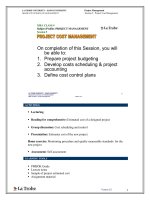Cost management training day3
Bạn đang xem bản rút gọn của tài liệu. Xem và tải ngay bản đầy đủ của tài liệu tại đây (306.46 KB, 61 trang )
Training Agenda/Objectives
•
Day 1: Cost Management Overview
–
Understanding of why managing costs are important, Army’s overall objectives, the process of Cost
Management, how it differs from Budget, and key cost terms
•
Day 2: Cost Object Definition
–
Understanding of an ERP, how to build a Cost Model, and the various cost objects within a Cost Model (e.g.
organization, products, job orders, etc.)
•
Day 3: Assignment of Costs
–
Understanding of cost allocations/assignments, how to chose which to utilize when, how to valuate the results
of the assignments (Std. vs Actual), and rate creation
•
Day 4: Analysis and Reporting
–
D3L1_p1
Understanding of the results of the Cost Model and how various types of analysis and decisions are supported
Day 3 Objective & Agenda
Day 3: Assignment of Costs
•
Understanding of cost allocations/assignments, how to chose which to utilize when, how
to valuate the results of the assignments (Std. vs Actual), and rate creation
–
–
–
–
–
–
–
D3L1_p2
Lesson 1: Cost Assignments Overview
Lesson 2: Direct Activity Allocation
Lesson 3: Assessment Cycles
Lesson 4: Indirect Activity Allocation, Target/Actual, and Templates
Lesson 7: Overhead Costing Sheet
Lesson 8: Costing Assignment Methods Comparison
Lesson 9: Standard vs. Actual & Depreciation
Lesson 1: Cost
Assignments Overview
Objective(s):
•
•
D3L1_p3
To provide a high level understanding of the types of cost assignments
To understand what allocations and assignment are used for
Cost Model Cost Objects
Full Cost
Full Cost
Full Cost
Organizations
Product/Services
Customers
SSPs Provided
Director of
Cost Center
•
First step of the Cost Model is to
Logistics)
define how the various cost
SSPA: Manage
OCIE Inventory
Brigade XXX
objects will be utilized
SSPB: Issue
•
OCIE to Soldier
Cost Center/Resource Pool
Military
Then the relationships between
the cost objects have to be
Labor
Central Issue facility
SSPC: Issue
Clothing to Initial
TRADOC YYY
Training Soldier
relationships are reflected in the
assignments and allocations
CIV
Depreciation
Civilian
SSPD: Accept
HR
defined
OCI Turn-Ins
Employees
SSPE: Receive
CNT
Contractors
HR
Brigade ZZZ
& Process
Shipments
Military
SSPF: Manage
MIL
HR
D3L1_p4
Chemical Defense
Equipment
analyzed and modeled. The
. . Etc.
Cost Flow Overview
Allocations and Assignments are utilized in order to reflect the cost flows of the
organization providing the ability to:
•
•
•
D3L1_p5
Determine the full costs of products/services (for both plan and actual)
Determine the full costs of customers (for both plan and actual)
Understand the how the organization can influence the costs through their behavior
Assignment vs. Allocation
Assignment:
Allocation:
The establishment of relationship between a sending cost object and a receiving
The establishment of a relationship between a sending cost object to one or
cost object based on a quantity (with a rate for valuation) being consumed by
more receiving cost object(s) based on % (even if a quantity is utilized to
the receiver
generate a %, e.g. # FTEs)
Requires:
Requires:
•
•
•
•
Activity Type or Business Process quantity as sender
Mechanism for capturing a quantitative or monetary value on the receiver(s)
which is then utilized to determine the % split of the sender costs
A rate associated to valuate the quantity flow
Mechanism for capturing or imputing the sender quantity
•
Acceptance of batch processing
CC 1
10
$220
-$200
@
CC 1
1
10 Hrs
$220
Hr
Order
$1
10 @
D3L1_p6
1
Order
50
%
Order
0
$1
0
2
-$220
Order
50%
2
10 Hrs
Assignment vs. Allocation
Assignment:
Allocation:
Pros:
Pros:
•
•
•
•
•
•
Direct relationship
Provides mechanism for cost association when tracking of quantity is not
possible or cost prohibitive
Real-time information for analysis
Reduces systemic burden during period close
Dynamic (can change as the environment changes)
Capacity Mgmt (resource utilization)
Cons:
•
Must have the ability to track quantity from send to receiver or impute
Cons:
•
•
•
•
D3L1_p7
Full-absorption approach
Typically less accurate
High demand on system resources during period-end close
Static assumption set often infrequently updated
Allocation to Assignment
Maturation Process
100%
80%
Value-Based
60%
40%
Quantity-Based
20%
0%
Year 1
Year 2
Year 3
Year 4
Year 5
Year N
•
As the Army’s Management Accounting framework matures over time, utilization between cost allocation versus assignment methods will shift.
•
Value-based: Cost allocations utilizing tracing factors that result in the allocation of dollars between cost objects, e.g. % split or quantitative
information such as # FTEs. The result is the cost flow of dollars only. Supports current costing with limited management control and projection
capabilities.
•
Quantity-based: Cost assignments utilizing the quantity of goods and services provided between cost objects, e.g. # Hrs, SQFT, CPUMINS, etc. The
result is the flow of quantities between cost objects with a corresponding monetary valuation. Therefore both quantities and dollars flow. Supports
current costing with management control and projection capabilities.
D3L1_p8
Cost Assignments and Allocations
Today:
Tomorrow (GFEBS):
Not All Cost Allocated
Focused on Direct Obligation by Appropriation
Assigned / Mapped to High Level Programs (e.g. MDEP)
Allocation Done Differently by Organization
Standardized Process
Will Use Acceptable Cost Assignment/ Allocation Practices
Will Provide Capability for Multiple Cost
Assignments/Allocations
Allocations Only where Direct Assignments not Used
•
•
•
•
Inconsistent Army Reporting
Not Full Cost
Financial Focus to Meet Budget Execution Reports
Not linked to Output
D3L1_p9
•
•
•
•
Required for Full Cost Accuracy
More Accurately Defines Overhead & Indirect Cost
Maintains Budget Execution Capability
Linked to Output
What Assignments/Allocations Are Currently Performed?
•
•
•
•
•
•
•
Space Allocation (received from IMCOM)
Space Allocation (for courses, classes)
Admin/teaching staff’s time?
Lecture room usage?
Office supplies stock?
Library costs?
Current Cost transfers for?
Cost Assignment/Allocation
Methods Supported by SAP
1.
2.
3.
4.
5.
6.
Direct Activity Allocations/Confirmations
Cycles (e.g. Assessment)
Indirect Activity Allocation Cycle
Target = Actual
Template Allocation
Overhead Costing Sheets
Choosing Assignment / Allocation Methods
Questions to ask:
•
Are quantities known?
–
If yes, what kind of quantity is known? Is it the quantity between sender and receiver? Or
just of the receiver?
–
•
•
•
Is it the quantity relationship between sender/receiver (i.e. std. qty)
When is the information needed (e.g. real-time, monthly)?
Is the information needed in actual only or is it also used for planning?
Are there complexities/weighting factors?
Lesson 1: Wrap-Up
•
Assignments are the establishment of relationship between a sending cost object and a receiving
cost object based on a quantity (with a rate for valuation) being consumed by the receiver
•
Allocations are the establishment of a relationship between a sending cost object to one or more
receiving cost object(s) based on % (even if a quantity is utilized to generate a %, e.g. # FTEs)
•
Assignments and allocations are necessary in order to supoort the Full Cost of Organizations,
Products/Services, and Customers
•
Assignments should be utilized where possible unless the quantities cannot be tracked or are cost
prohibitive in comparison to the information provided
D3L1_p13
Questions
•
__________ are utilized to send costs from the sender cost object to the receiver cost objects(s)
based on %
•
__________ are utilized to send costs from the sender cost object to the receiver cost object
based on the sender cost object quantity using a rate for valuation
•
SAP has 2 allocation/assignment methods?
o
o
X
D3L1_p14
True
False
Lesson 2:
Direct Activity Allocation
Objective(s):
•
•
•
•
D3L2_p1
Understand what is a direct activity allocation
Walk through an example
Understand how it is currently used
Learn how will be supported within GFEBS
Direct Activity Allocations
Definition
Definition
The direct recording and posting of either an activity type (resource driver) or a process (activity driver) quantity. This method is a direct charging of
the quantity to the receiver.
SSP A: PROVIDE LEGAL ASSISTANCE
Labor Costs
2ABM0014
LEGAL (ILO)
CIV HR
SSP B: LEGAL ASSISTANCE (ADVERSE ACTIONS)
Labor Costs
•
•
D3L2_p2
Must know the quantity of the sender being consumed by the receiver(s)
Real-time posting unless batch interfaced in from a source system
Direct Activity Allocations
Example
SSP A:
2ABM0014: LEGAL (ILO)
LEGAL ASSISTANCE (ADVERSE ACTIONS)
Name
Cost Element
Amount
Quantity
Perm
Perm
6100.11B1
6100.11B1
$5,000
$5,000
100
100 hrs
hrs
60 hrs
Name
Cost Element
Labor
9300.0100
Amount
$3,000
Quantity
60 hrs
at
Labor
9300.0100
($4000)
80 hrs
$50/hr
CIV HR
SSP B:
20 hrs
at
LEGAL ASSISTANCE (ADVERSE ACTIONS)
Name
Cost Element
Labor
9300.0100
Amount
Quantity
$50/hr
Qty is valuated
with rate
D3L2_p3
$1,000
20 hrs
Direct Activity Allocation
How Currently Used?
•
D3L2_p4
What examples are there currently which would match a Direct Activity Allocation?
Direct Activity Allocation
How Supported in GFEBS
•
Used to reflected the ATAAPS time entered “directly” against an SSP – this
information will feed into GFEBS and charge the Cost Center/Activity Type out to the
receiving SSP
•
Confirmations within GFEBS are a form of Direct Activity Allocations.
–
Used to reflect the DPW work to an order for Equipment, GSA Vehicles, and DPW work hrs
(DPW Hrs to work orders are not charged out in ATAAPS)
D3L2_p5
Lesson 2: Wrap-Up
•
A direct activity allocation is the direct recording and posting of either an activity
type (resource driver) or a process (activity driver) quantity. This method is a direct
charging of the quantity to the receiver.
•
•
•
Requires the sender cost object quantity to be known by receiver
Is a real-time posting providing information immediately
The cost flowed from the sender to the receiver is based determined by the rate *
quantity charged
D3L2_p6
Questions:
1.
Direct Activity Allocations provide information on the quantity and the dollars related to the
sender/receiver relationship?
o
o
True
False
2. Direct Activity Allocations are batch run at the end of the period?
o
o
True
False
X
3. When is Direct Allocation preferred and what information is needed?
ALWAYS!
D3L2_p7
Lesson 3: Assessment Cycles
Objective(s):
•
•
D3L3_p1
Understand what are cycles
Learn about Assessment cycle
What Are Cycles?
•
•
Cycles are a form of allocation within GFEBS
Used when tracking of the actual quantity between sender and receiver is not
available or is cost prohibitive
•
•
Run at the end of a period (i.e. batch oriented not real-time)
Allow for the set-up of individual sender/receiver relationships or groups of senders
to groups of receivers
•
Support various cost basis as the determine of the % split to the receivers (e.g. $s,
hrs, SKFs, %s, etc.)
D3L3_p2
Cycles Overview
“Are there cost drivers available for allocations?”
•
•
•
•
•
Labor HRs
% Time
Labor $s
SQ FT
Etc.
Receiver Cost Center1
Sender Cost Center
Name
Cost
Cost Element
Sender Cost Center
XXXX
Allocated Costs
Amount
50%
$ZZZZ
Name
Cost Element
Amount
Cost
XXXX
$ZZZZ
50%
Receiver Cost Center1
Allocated Costs
D3L3_p3
Assessment Cycles
Definition
A value-based allocation method that uses an aggregate account to move both primary (G/L accounts) and secondary cost elements (internal
allocation accounts) between senders and receivers.
2ABM0066: CONSOL ISSUE FAC
2ABM0008:
2ABM0008: DIR.
DIR. OF
OF LOGISTICS
LOGISTICS
Name
Name
Cost
Cost Element
Element
Labor
Labor
6100.11B1
6100.11B1
$10,000
$10,000
Travel
Travel
6100.21T0
6100.21T0
$4,000
$4,000
Supplies
Supplies
6100.261B
6100.261B
$2,000
$2,000
50% of
DOL Support
9100.0000
($16,000)
Labor $
D3L3_p6
Amount
Amount
50% of
Labor $
Name
Cost Element
Amount
Labor
6100.11B1
$2,000
Travel
6100.21T0
$2,000
DOL Support
9100.0000
$8,000
2ABM0061: FOOD SVC & BR
Name
Cost Element
Amount
Labor
6100.11B1
$2,000
Travel
6100.21T0
$1,000
DOL Support
9100.0000
$8,000









